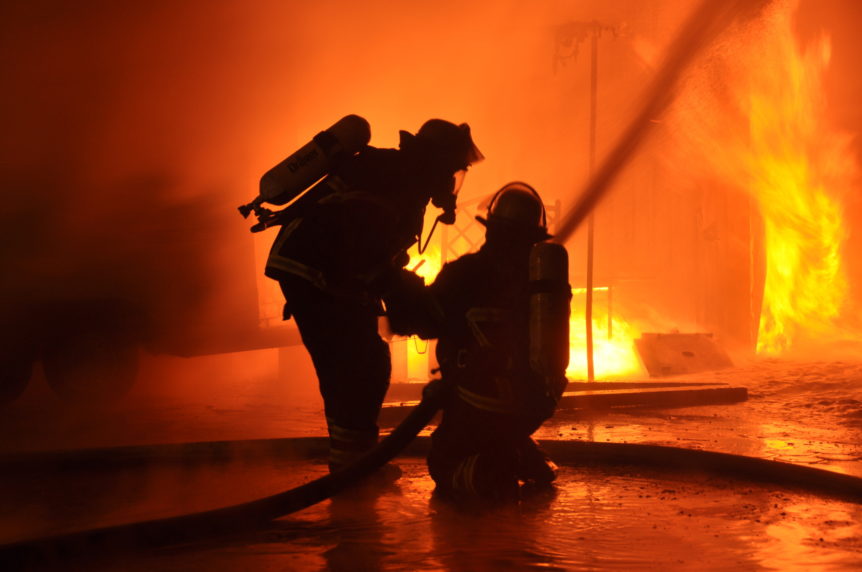There are few things more intimidating to a home or business owner than the potential for a fire to erupt and destroy property. It’s important to learn and be aware of how to put out a fire efficiently and effectively if the worst happens.
How to Put out a Fire
For safety reasons, we strongly recommend the use of a fire extinguisher to put out a fire. Far too often, owners haven’t invested in purchasing fire extinguishers. But they remain the most reliable instruments you can use to fend off a small-scale blaze before it grows. However, it’s important to recognize that, for best results, you’ll need a fire extinguisher specifically designed to fight the relevant class of fire you’re fighting.
The 4 Classes of Fire
There are 4 classes of fire. They’re known as types A, B, C, and D.
“A” fires are perhaps the most familiar, fed by ordinary combustibles like wood, paper, and so on. “B” fires, meanwhile, are created by flammable liquids like gasoline, oil and grease. “C” fires originate via electrical incidents. And “D” fires are produced by flammable metals like magnesium.
It’s common to see fire extinguishers possess more than one classification marked on them. For example, the most common extinguisher is an “ABC” designed to properly fight 3 of the most common kinds of fire: A, B, and C (ordinary combustibles, flammable liquids, and electrical-related flames).
In the event of an emergency and in the absence of an available fire extinguisher, a little personal knowledge about how fire works could help make a difference. Generally speaking, a fire needs 3 things to keep growing: fuel, heat, and oxygen. If you can remove 1 or more of those components, a fire will become weakened and eventually die out.
For any kind of fire, eliminating an active fuel or heat source is one of your best available solutions if doing so is clearly safe. Safely turning off a relevant natural gas supply, electrically-powered machine, and/or electrical breaker can make a big difference.
The 3 most common fires in a home environment are types A, B, and C. Our recommendation is to invest in and learn how to operate a fire extinguisher. But the following brief advice talks about how to deal with these different kinds of fires without one.
Type A: Ordinary Combustible Material Fires
Was the fire was caused by an ordinary combustible material? Fires involving ordinary combustible materials like wood and paper can be extinguished with water! Water removes both heat and oxygen, effectively suppressing the fire.
Type B: Flammable Liquid Fires
Does the fire involve flammable liquids?
Flammable liquids like gasoline, oil, or grease most commonly produce fires in the kitchen or garage. Please note that for these fires, loose water is not recommended because the flammable liquid might actually float on top of the sprayed water and continue to burn (spreading even faster).
If a type B fire occurs in your kitchen, try to safely get access to a supply of baking soda. And use it! Sodium bicarbonate (aka baking soda) is the main chemical ingredient in type B fire extinguishers and can work well against grease fires. This is strictly limited to baking soda, though. Other pantry staples like sugar and flour can only make a fire worse. Don’t have baking soda on hand? A safely accessible pot lid will help to starve a fire of oxygen. You can also use a wet towel.
Remember that if a fire is within an appliance (like inside of an oven or microwave), it’s best to close the appliance and immediately turn off your home’s gas supply or electricity. If a fire starts in your garage, you can try and smother it with dirt or (as in the kitchen) with a wet towel or blanket.
Type C: Electrical Fires
Wondering how to put out a fire that is electrical?
If there was ever a fire not to use water to fight, it’s this one. Unless water is distilled, it will conduct electricity and only worsen the hazard. This is not even to mention the fact that joining water and electricity can pose an extreme hazard to your safety and life. When you encounter an electrical fire, your initial goal should be to turn off your home’s electricity by accessing the breaker. However, if this is not possible or safe, you should seek to smother the fire with anything non-conductive and non-flammable. A dry, non-flammable blanket would work too, as could baking soda.
Turning off your home’s power is the reliable way to treat a Type C fire as you would a Type A or Type B fire, depending on what is burning.
Have a Fire Extinguisher on Hand
Despite all of this, it’s best to have a fire extinguisher on hand. Don’t forget that an extinguisher should be your primary “go to” means of fighting a fire. Short of calling the fire department, it is the only method we actively recommend. If you own an extinguisher and feel comfortable operating it, remember P.A.S.S.:
- Pull the pin
- Aim the nozzle
- Squeeze the handle
- Sweep the chemicals over the fire
When a Fire Is Out of Control
Please remember that if there is any doubt in your mind that you can’t extinguish the fire on your own, call 911 immediately for help. It’s always beneficial to have help on the way just in case, especially if a fire is swelling in size.
If the flames are obviously too large for you to extinguish, don’t fight them. Get out of the building and call for help. Fighting a large fire is for professionals; it’s simply too dangerous without the proper training.
If you are interested in making your work environment safer from a potential fire, feel free to contact us for a quote on designing and installing fire detection and suppression equipment and systems into your commercial property.

